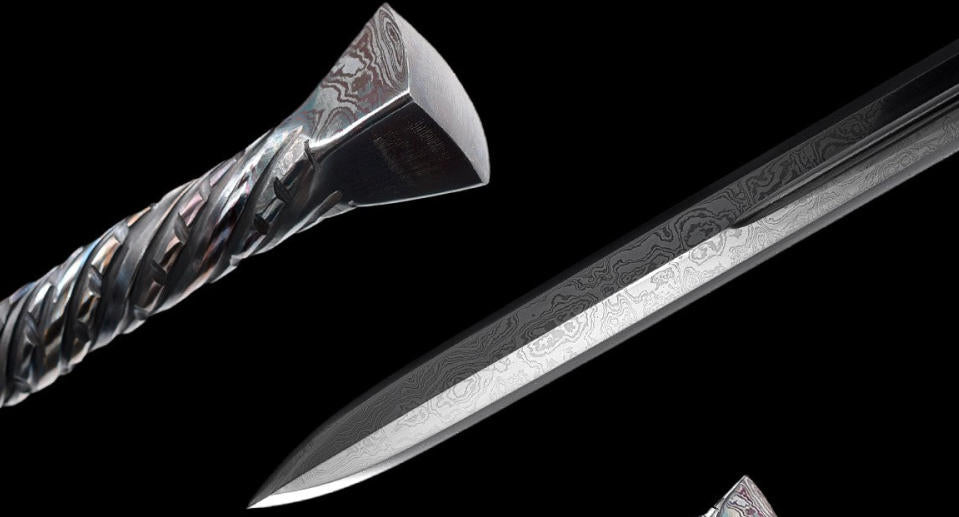ขวานและดาบต่อสู้ในยุคกลาง: จากประวัติศาสตร์สู่การสะสมสมัยใหม่

ขวานและดาบรบในยุคกลางประเภทใดเหมาะที่สุดสำหรับการสะสมหรือใช้งานจริง?
อาวุธยุคกลาง (https://en.wikipedia.org) ไม่เพียงแต่เป็นเครื่องมืออันตรายในสนามรบเท่านั้น แต่ยังเป็นสัญลักษณ์ของสถานะและอำนาจของอัศวินและทหารอีกด้วย ในประวัติศาสตร์ของขวานและ อาวุธดาบ ในยุคกลาง เราจะเห็นว่าอัศวิน นักรบ และกองทัพยุโรปได้จารึกตำนานของพวกเขาผ่านทักษะและความเชี่ยวชาญด้านอาวุธอย่างไร ตั้งแต่ ขวานรบยุคกลาง ที่มีบันทึกทางประวัติศาสตร์ ไปจนถึง ขวานรบจริง ที่นักสะสมสมัยใหม่แสวงหา อาวุธเหล่านี้ล้วนมีคุณค่าทางวัฒนธรรมและงานฝีมืออย่างมหาศาล
การพัฒนาและประเภทของขวานรบยุคกลาง
ขวานรบยุคกลาง เป็นอาวุธสำคัญในสนามรบ ขึ้นชื่อเรื่องความสามารถในการเจาะและสับเกราะ ไม่ว่าจะเป็นการต่อสู้ระยะประชิดระหว่างอัศวินและทหารราบ หรือระหว่างการปิดล้อมและการรบขนาดใหญ่ ขวานรบมีบทบาทสำคัญอย่างยิ่ง ขวานรบสามารถจำแนกตามการใช้งานเชิงยุทธวิธีและการออกแบบได้ดังนี้:
-
ขวานรบมือเดียว (ขวานรบยุคกลาง)
ขวานมือเดียวมีน้ำหนักเบาและใช้งานได้หลากหลาย จึงสามารถถือโดยอัศวินหรือทหารราบพร้อมกับโล่ได้ หัวขวานมักมีคมเดียวหรือสองคม ช่วยให้โจมตีได้อย่างรวดเร็ว เหมาะสำหรับการต่อสู้ระยะประชิดกับศัตรูหลายคน ขวานมือเดียวยังสามารถใช้ร่วมกับอาวุธอื่นๆ เช่น ดาบสั้นหรือมีดสั้น เพื่อความสมดุลทั้งการรุกและรับ -
ขวานรบสองมือ (ขวานรบยุคกลาง / ขวานสงครามยุคกลาง)
ขวานสองมือขนาดใหญ่และหนักถูกออกแบบมาเพื่อทำลายแนวป้องกันและเจาะเกราะหนัก อัศวินหรือทหารใช้ขวานทั้งสองมือเพื่อโจมตีอย่างรุนแรง ทำให้เกิดความเสียหายอย่างรุนแรงในการปิดล้อมหรือการต่อสู้ที่เด็ดขาด นอกจากจะเป็นอาวุธแล้ว ขวานยังทำหน้าที่เป็นเครื่องยับยั้งทางจิตวิทยาในสนามรบอีกด้วย -
ขวานต่อสู้ (ขวานต่อสู้ยุคกลาง / ขวานพร้อมรบ)
ขวานต่อสู้ถูกออกแบบมาเพื่อความสมดุลระหว่างการรุกและการป้องกัน มีขนาดสั้นกว่าและช่วยให้สามารถฟันได้อย่างคล่องแคล่ว เหมาะสำหรับการรบของทหารราบที่หนาแน่น ฝีมือประณีต ใบมีดที่คมกริบ และความทนทาน ทำให้ขวานเหล่านี้เหมาะอย่างยิ่งสำหรับอัศวินและนักรบ ขวานจำลองสมัยใหม่ยังคงรักษาเทคนิคดั้งเดิมไว้ ทำให้นักสะสมสัมผัสได้ถึงพลังและเนื้อสัมผัสของขวานดั้งเดิม
ขวานรบยุคกลางไม่ได้ถูกออกแบบมาเพื่อประสิทธิภาพในการต่อสู้เท่านั้น แต่ยังแสดงให้เห็นถึงฝีมืออันประณีตอีกด้วย หัวขวานที่คมกริบถูก ตีขึ้นด้วยมือ ตีซ้ำๆ เพื่อขจัดสิ่งสกปรกออก ทำให้โครงสร้างเหล็กมีความสม่ำเสมอและความทนทานยิ่งขึ้น ด้ามจับซึ่งมักทำจากไม้หรือเหล็กกล้าที่มีความแข็งแรงสูง ช่วยให้มั่นคงและปลอดภัยขณะเหวี่ยง ฝีมืออันประณีตนี้ทำให้ ขวานรบที่แท้จริง น่าเกรงขามในสนามรบและเป็นที่ต้องการของนักสะสมสมัยใหม่
นอกจากนี้ ขวานยุคกลางยังเป็นสัญลักษณ์ของฐานะอีกด้วย ขุนนางและอัศวินมักสลักตราประจำตระกูล ลวดลาย หรือจารึกไว้บนขวาน เพื่อเพิ่มทั้งความสวยงามและเกียรติยศ การผสมผสานระหว่างประโยชน์ใช้สอยและความสำคัญทางวัฒนธรรมนี้ทำให้ ขวานรบยุคกลาง / ขวานสงครามยุคกลาง มีความสำคัญทั้งทางประวัติศาสตร์และในตลาดนักสะสมในปัจจุบัน
ดาบ: สัญลักษณ์ของอัศวินและตำนานยุคกลาง
นอกเหนือจากขวานแล้ว ดาบยังเป็นอาวุธที่ขาดไม่ได้สำหรับอัศวินและนักรบ ในฐานะ สัญลักษณ์ของอัศวิน ดาบยังแสดงถึงเกียรติยศและสถานะเทียบเท่ากับความสามารถในการต่อสู้ ในบรรดาดาบยุคกลาง ดาบสำหรับ ติดอาวุธถือเป็นอาวุธ ที่โดดเด่นที่สุด ดาบมีน้ำหนักเบาและใช้งานได้หลากหลาย สามารถใช้มือเดียวควบคู่ไปกับโล่ ช่วยให้แทงและฟันได้อย่างรวดเร็ว เหมาะสำหรับการดวลและการต่อสู้ในสนามรบ
ดาบยุโรปเรียกว่าอะไร?
ดาบยุโรปมีชื่อเรียกแตกต่างกันไปตามรูปทรง วัตถุประสงค์ และยุคสมัย ประเภทดาบที่พบบ่อย ได้แก่:
-
ดาบอาวุธ : ดาบตรงมือเดียวที่ใช้กันทั่วไปในยุคกลาง ใช้โดยอัศวิน มักจับคู่กับโล่
-
ดาบยาว : ดาบสองมือที่มีใบดาบยาวกว่า ใช้งานได้ทั้งมือเดียวและสองมือในการฟันและแทง
-
เคลย์มอร์ : ดาบสก็อตแลนด์สองมือขนาดใหญ่ ออกแบบมาเพื่อการต่อสู้ที่หนักหน่วง
-
ฟัลชิออน : ดาบคมเดียวที่มีใบดาบโค้งเล็กน้อย เหมาะสำหรับการฟันและการใช้งานน้ำหนักเบา
-
ดาบเรเปียร์ : ดาบแทงที่มีน้ำหนักเบา นิยมใช้ในยุคฟื้นฟูศิลปวิทยา ส่วนใหญ่ใช้ในการดวล
-
กระบี่ : ดาบโค้งที่ใช้โดยทหารม้าเพื่อโจมตีเป็นหลัก
-
ดาบหอก / สปาธา : ดาบยาวยุคแรกของยุโรปที่ได้รับอิทธิพลจากการออกแบบของชาวโรมัน เหมาะสำหรับการแทงและสับ
“ดาบยุโรป” เป็นคำทั่วไป โดยแต่ละประเภทจะสอดคล้องกับช่วงเวลาทางประวัติศาสตร์และความต้องการในการต่อสู้ที่เฉพาะเจาะจง
ดาบในตำนานในประวัติศาสตร์
-
ซิโฟส (ดาบสั้นกรีก)
ดาบ Xiphos มีต้นกำเนิดในกรีกโบราณ และมีอิทธิพลต่อการออกแบบดาบยุโรปในยุคหลัง ด้วยใบดาบสองคมที่เบาและคมกริบ ดาบจำลองสมัยใหม่ยังคงรักษาดีไซน์และสัมผัสดั้งเดิมไว้ ซึ่งเป็นที่นิยมในหมู่ผู้ที่ชื่นชอบดาบโบราณ -
อันดูริล เปลวไฟแห่งทิศตะวันตก
จากนวนิยาย เรื่อง The Lord of the Rings ของโทลคีน ดาบในตำนานเล่มนี้เป็นสัญลักษณ์ของความยุติธรรม ความกล้าหาญ และความไม่หวั่นเกรง สื่อสมัยใหม่มักเน้นย้ำถึงความคมกริบและรูปลักษณ์อันสง่างาม ทำให้ดาบเล่มนี้เป็นที่นิยมในหมู่นักสะสมและคอสเพลย์ แม้จะเป็นเพียงดาบในจินตนาการ แต่การออกแบบก็มีความคล้ายคลึงกับดาบอัศวินยุคกลาง -
ดาบซีรีส์ Warlegend
ดาบจำลองสมัยใหม่ในซีรีส์ Warlegend มุ่งหวังที่จะจำลองน้ำหนัก ความสมดุล และความคมของดาบยุคกลาง ดาบเหล่านี้สร้างขึ้นเพื่อใช้เป็น ดาบสำหรับการต่อสู้ หรือ ขวานรบจริง สามารถใช้เป็นของสะสมเพื่อจัดแสดงหรือใช้ในการจำลองเหตุการณ์ทางประวัติศาสตร์ มอบประสบการณ์การต่อสู้แบบอัศวินที่สมจริงให้กับผู้ที่ชื่นชอบ
จุดเด่นของผลิตภัณฑ์: ดาบยุโรปตีขึ้นมือ – ดาบหอกพร้อมเหล็กพับและฝักหนังสีดำ
ดาบยุโรปที่ตีขึ้นด้วยมือ นี้ผสมผสานการออกแบบดาบแบบคลาสสิกกับงานฝีมือที่ทันสมัย เหมาะสำหรับนักสะสมและผู้ที่ชื่นชอบประวัติศาสตร์
-
วัสดุใบมีด : ผลิตจาก เหล็กพับ คุณภาพพรีเมียม ตีและพับซ้ำๆ เพื่อให้มั่นใจถึงความแข็งแกร่ง ความยืดหยุ่น และรูปแบบใบมีดที่เป็นเอกลักษณ์ ผสมผสานความสวยงามเข้ากับความสะดวกในการใช้งาน
-
งานฝีมือ : ตีขึ้นมือ ทั้งหมดและ ขัดเงาด้วยมือ เพื่อความคมและการจับที่สะดวกสบาย เหมาะสำหรับการฝึกตัดเบาๆ หรือการจัดแสดง
-
การออกแบบฝักดาบ : มาพร้อม ฝักดาบหนังสีดำ ที่ช่วยปกป้องใบดาบพร้อมเพิ่มความสวยงามแบบวินเทจ เหมาะสำหรับการพกพาและจัดแสดง
-
ฟังก์ชั่นและการใช้งาน : มีทั้งมูลค่าสะสมและประสบการณ์การต่อสู้เบาๆ เหมาะสำหรับการจัดแสดง คอสเพลย์ การแสดงประวัติศาสตร์ หรืออุปกรณ์ประกอบฉากในภาพยนตร์
-
รูปลักษณ์ : เส้นใบมีดเรียบ สัดส่วนสมดุล ขอบคมและแม่นยำ สะท้อนถึงสไตล์นักรบยุโรปคลาสสิก
ดาบหอก นี้ไม่เพียงแต่เป็นอาวุธเท่านั้น แต่ยังเป็นงานศิลปะที่แสดงให้เห็นถึงฝีมือการตีด้วยมือและพลังแห่งวิชาดาบยุโรปในยุคกลาง
ขวานและดาบต่อสู้ในยุคกลาง: จากประวัติศาสตร์สู่การสะสมสมัยใหม่
ในยุคกลาง ดาบไม่ได้เป็นเพียงแค่อาวุธในสนามรบเท่านั้น แต่ยังเป็นสัญลักษณ์ของอัตลักษณ์และจิตวิญญาณของอัศวิน อัศวินที่ถือดาบไม่เพียงแต่ต้องการทักษะอันโดดเด่นเท่านั้น แต่ยังต้องยึดมั่นใน ความ เป็นอัศวิน ซึ่งสะท้อนถึงความภักดี ความกล้าหาญ เกียรติยศ และความยุติธรรม ทักษะการใช้ดาบได้ทดสอบความแข็งแกร่ง กลยุทธ์ และสติปัญญา ทุกการแทง การฟัน และการปัดป้องล้วนสะท้อนถึงความเชี่ยวชาญในศิลปะการต่อสู้ของอัศวิน
ด้วยเหตุนี้ นักสะสมสมัยใหม่ที่กำลังมองหา ขวานพร้อมรบ / ขวานพร้อมรบ / ขวานพร้อมรบ หรือ ขวานรบจริง / ขวานรบจริง มักให้ความสนใจในดาบเป็นอย่างมาก พวกเขาต้องการเป็นเจ้าของหรือสัมผัสประสบการณ์ การต่อสู้ที่แท้จริง (ขวานรบยุคกลาง / ดาบสำหรับติดอาวุธ) สัมผัสน้ำหนัก ความสมดุล และแรงกระแทกที่แท้จริงของอาวุธอัศวินในยุคกลาง ทั้งดาบและขวานยังคงเป็นสัญลักษณ์สำคัญของวัฒนธรรมการทหารยุคกลาง ไม่ว่าจะเพื่อการใช้งานจริงหรือเพื่อจัดแสดง
ฝีมือการประดิษฐ์ดาบและวัสดุ
การทำดาบในยุคกลางเน้นการตีและการขัดเงา โดยดาบแต่ละเล่มแสดงถึงทักษะและความรู้ของช่างตีเหล็ก เหล็กกล้าคุณภาพสูงถูกตีซ้ำหลายครั้งเพื่อให้มั่นใจว่าคาร์บอนกระจายตัวสม่ำเสมอและขจัดสิ่งเจือปน จากนั้นจึงทำการ ชุบแข็ง และ อบคืนตัว เพื่อให้ได้ใบมีดที่คมกริบและยืดหยุ่นเป็นพิเศษ ทนทานต่อการต่อสู้ที่รุนแรงโดยไม่แตกหัก
ดาบก็ถูกตกแต่งอย่างสวยงามเช่นกัน ด้ามดาบ ปลอกดาบ และฝักดาบมักสลักตราประจำตระกูลหรือลวดลายอันวิจิตรบรรจง สะท้อนถึงฐานะและเกียรติยศของเจ้าของ การตกแต่งเหล่านี้ช่วยเพิ่มความสวยงามและทำให้ดาบเป็นสิ่งประดิษฐ์หายากที่ผสมผสาน การใช้งานในการต่อสู้ คุณค่าทางศิลปะ และความสำคัญทางวัฒนธรรม

มูลค่าการสะสมดาบสมัยใหม่
นักสะสมในปัจจุบันไม่เพียงแต่แสวงหา ดาบที่พร้อมรบ เท่านั้น แต่ยังแสวงหาโอกาสที่จะได้สัมผัสจิตวิญญาณของอัศวินยุคกลางอีกด้วย ดาบจำลองสำหรับ ติดอาวุธ ดาบยาว หรือ ดาบต่อสู้ยุคกลาง มักใช้วิธีตีแบบดั้งเดิมด้วยมือ ซึ่งเหมาะสำหรับการจัดแสดง การแสดงจำลองเหตุการณ์ทางประวัติศาสตร์ การฝึกดาบ หรือการคอสเพลย์
โดยพื้นฐานแล้ว ดาบยุคกลางไม่ได้เป็นแค่อาวุธเท่านั้น แต่ยังเป็นตัวแทนของวัฒนธรรม เกียรติยศ และฝีมือของอัศวิน การศึกษาหรือสะสมดาบเหล่านี้ช่วยให้ผู้ที่ชื่นชอบได้สัมผัสกับยุคสมัยแห่งความกล้าหาญและเกียรติยศอันเลื่องชื่อ
สนามรบและเรื่องราวในตำนาน: ความรุ่งโรจน์ของอาวุธยุคกลาง
ในยุคกลาง ขวานและดาบไม่ได้เป็นเพียงแค่อาวุธเย็นเท่านั้น แต่ยังเป็นตัวแทนของกลยุทธ์ทางทหารและเกียรติยศของอัศวิน ขวานรบในยุคกลาง และ ขวานต่อสู้ในยุคกลาง ถูกใช้อย่างกว้างขวางในการปิดล้อม การบุกโจมตี และการต่อสู้ระยะประชิด ด้วยพลังเจาะเกราะที่แข็งแกร่งและความคล่องแคล่ว ขวานเหล่านี้จึงกลายเป็นเครื่องมือสำคัญสำหรับทหารและอัศวิน ขวานสองมือ ( ขวานรบยุคกลาง / ขวานรบยุคกลาง ) สามารถแยกโล่และชุดเกราะได้อย่างง่ายดาย ในขณะที่ขวานมือเดียว ( ขวานรบยุคกลาง / ขวานพร้อมรบ ) ช่วยให้อัศวินและทหารราบสามารถโจมตีได้อย่างรวดเร็วและปรับตัวในการต่อสู้ที่วุ่นวาย
ดาบก็มีความหมายเชิงสัญลักษณ์ไม่แพ้กัน อาวุธที่ใช้คือดาบ ดาบ ซิโฟส และดาบชนิดอื่นๆ มีบทบาทสำคัญในการต่อสู้และกลายเป็นสัญลักษณ์ทางวัฒนธรรม ตำนานดาบของกษัตริย์อาเธอร์ ได้เปลี่ยนดาบให้กลายเป็นสัญลักษณ์แห่งความกล้าหาญ เกียรติยศ และปัญญา ผ่านการผสมผสานระหว่างตำนานและประวัติศาสตร์ ดาบและขวานจึงกลายเป็นสัญลักษณ์แห่งจิตวิญญาณของนักรบยุคกลาง
การสะสมที่ทันสมัยและประสบการณ์จริง
ความสนใจในขวานและดาบยุคกลางยังคงเติบโตอย่างต่อเนื่องในหมู่ผู้ที่ชื่นชอบประวัติศาสตร์และวัฒนธรรม นักสะสมต่างมองหา ขวานรบจริง / ขวานรบจริง และ ขวานรบจริง โดยให้ความสำคัญกับงานฝีมือและความสำคัญทางประวัติศาสตร์ แบบจำลองสมัยใหม่มักผสมผสานเทคนิคการตีแบบดั้งเดิมเข้ากับการออกแบบที่พร้อมรบ เช่น ขวานพร้อมรบ / ขวานรบพร้อมรบ ซึ่งเหมาะสำหรับการจัดแสดงหรือฝึกซ้อมการต่อสู้แบบเบา
นอกจากนี้ยังมีดีไซน์สไตล์โบราณและดีไซน์สร้างสรรค์หลากหลายรูปแบบเพื่อตอบสนองความต้องการที่หลากหลาย ไม่ว่าจะเป็น Battle Ace / Battle Ake / Battel Axe / Battle Ae / Warrior Combat Cane ไม่ว่าจะเป็นของตกแต่งบ้าน อุปกรณ์ประกอบฉากในภาพยนตร์ คอสเพลย์ หรือการฝึกศิลปะการต่อสู้ยุคกลาง แบบจำลองและดีไซน์ดั้งเดิมเหล่านี้จะช่วยให้ผู้ที่ชื่นชอบได้สัมผัสประสบการณ์ชีวิตอันเป็นตำนานของอัศวินและนักรบด้วยตนเอง
ผ่านการสะสมและการใช้งานจริง ผู้คนสามารถสัมผัสถึงความเข้มข้นของสมรภูมิยุคกลาง และเห็นคุณค่าของจิตวิญญาณอัศวินและสติปัญญาของนักรบ คำสำคัญเช่น ขวานรบยุคกลาง / ขวานรบยุคกลาง / ขวานพร้อมรบ / ดาบติดอาวุธ / ซิฟอส สะท้อนให้เห็นถึงการแสวงหาประวัติศาสตร์ที่แท้จริงและศิลปะการต่อสู้ในยุคปัจจุบัน
มีดทำครัวที่ได้รับแรงบันดาลใจจากอาวุธในยุคกลาง
ที่น่าสนใจคือ มีดทำครัวยุคกลางสมัยใหม่ ได้รับแรงบันดาลใจจากการออกแบบขวานและดาบ โดยผสมผสานความสะดวกในการใช้งานเข้ากับสุนทรียศาสตร์ทางประวัติศาสตร์ ทำให้มีดเหล่านี้เป็นตัวเลือกสองวัตถุประสงค์สำหรับนักสะสมและผู้ใช้ทั่วไป

บทสรุป
ตั้งแต่ ขวานยุคกลาง ไปจนถึง ขวานสำหรับใช้ดาบ จาก ขวานต่อสู้ยุคกลาง ไปจนถึง ขวานพร้อมรบ สมัยใหม่ อาวุธยุคกลางมีบทบาทสำคัญทางประวัติศาสตร์และยังคงได้รับความนิยมในวัฒนธรรมสมัยใหม่ ภาพยนตร์ และตลาดนักสะสม การศึกษาอาวุธเหล่านี้ช่วยให้ผู้ที่ชื่นชอบสามารถย้อนรอยประวัติศาสตร์ พร้อมกับสัมผัสจิตวิญญาณและฝีมือของนักรบยุคกลาง







